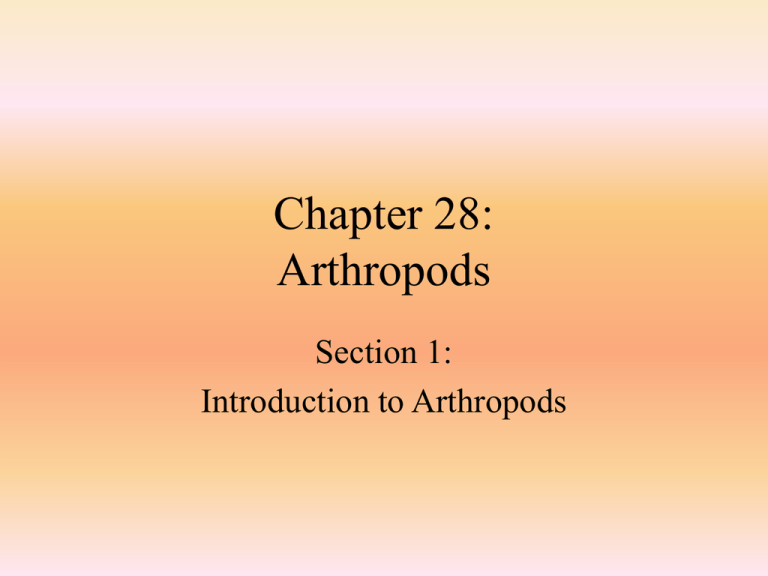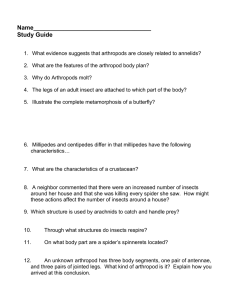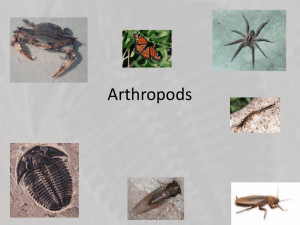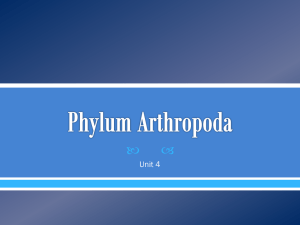Chapter 28: Arthropods
advertisement

Chapter 28: Arthropods Section 1: Introduction to Arthropods Introduction to Arthropods • Arthropod – animal having a segmented body, an exoskeleton containing chitin, and a series of jointed appendages; belong to the phylum Arthropoda – More than 1 million species have been described – Vary enormously in size, shape, and habits Diversity and Evolution in Arthropods • Arthropods are divided into four subphyla: – Trilobita • Oldest subphylum of arthropods • Trilobites were dwellers in ancient seas – Extinct – Chelicerata • Chelicerates include spiders, ticks, mites, scorpions, and horseshoe crabs – Crustacea • Crustaceans include such familiar (and edible) organisms as crab and shrimp – Uniramia • Uniramians include most arthropods: centipedes, millipedes, and all insects—including bees, moths, grasshoppers, flies, and beetles Spotted Cleaner Shrimp Flat Rock Scorpions Form and Function in Arthropods • All arthropods exhibit several key features – 3 most important features • Tough exoskeleton • Series of jointed appendages • Segmented body – Other characteristics • Brain located in dorsal part of head • Ventral nerve cord • Open circulatory system powered by a single heart California Spiny Lobster Deer Tick The Arthropod Body Plan • The exoskeleton is a system of external supporting structures that are made primarily of the carbohydrate chitin • Provide excellent protection from physical damage • Waterproof (terrestrial) – Prevents water loss • Helps arthropods move efficiently and adapt to their environment • Disadvantages – Cannot grow as the animal grows – Movement can occur only at the joints of the “armor” The Arthropod Body Plan • All arthropods have jointed appendages that enable them to move • Over millions of years, appendages have evolved into marvelously versatile adaptations to different environments – Antennae – Claws – Walking legs – Wings – Flippers • All arthropods have segmented bodies Feeding • Appendages enable these animals to eat almost any food you can imagine • Exhibit every mode of feeding – Herbivores • Some eat any plant, others are more selective – Carnivores • Some catch and eat other animals, others feed on animals that are primarily already dead Feeding – Parasites • External parasites drink blood or body fluids from animals, internal parasites passively absorb nutrients through body walls – Filter feeders • Use comb like bristles on mouthparts or legs to filter plants and animals from water – Detritus feeders Lubber Grasshopper-Herbivore Praying Mantis-Carnivore Respiration • Have evolved three basic types of respiratory structures—gills, book gills and book lungs, and tracheal tubes – Most have only one of these respiratory structures • Aquatic arthropods have gills just under the cover of their exoskeleton –Are formed from part of the same appendages that form mouthparts and legs Respiration • Book gills (horseshoe crabs) and book lungs (spiders and their relatives) are unique to these arthropods – Several sheets of tissue are layered like the pages of a book – Increase the surface area for gas exchange • Tracheal tubes (terrestrial arthropods) – From spiracles, long branching tracheal tubes reach deep into the animals’ tissues – Supplies oxygen by diffusion to all body tissues – Work well in only small animals Fiddler Crab--Gills Internal Transport • A well-developed heart pumps blood through an open circulatory system • When the heart contracts, it pumps blood through arteries that branch into smaller vessels and enter the tissues • There the blood leaves the vessels and moves through spaces in the tissues called sinuses • Eventually, the blood collects in a large cavity surrounding the heart, from which it re-enters the heart through small openings and is pumped around again Excretion • Undigested food becomes solid waste that leaves through the anus • Most terrestrial arthropods dispose of nitrogencontaining wastes by using a set of Malpighian tubules – Bathed in blood inside the body sinuses – Remove wastes from the blood, concentrate them, and then add them to undigested food before it leaves via the anus Excretion • Terrestrial arthropods may have small excretory glands by their legs instead of Malpighian tubules • Aquatic arthropods dispose of cellular wastes by diffusing them from the body into the surrounding water – Also eliminate nitrogen-containing wastes through a pair of green glands located near the base of the antennae • Are emptied to the outside through a pair of openings in the head The diamond beetle uses Malpighian tubules to get rid of nitrogen-containing wastes, whereas the hermit crab uses its green glands and gills. Response • Have well-developed nervous systems • All have a brain that consists of a pair of ganglia in the head • Have a nerve cord with several other pairs of ganglia – Serve as local command centers to coordinate the movement of legs and wings • Why insects can move after their heads are cut off Response • Have simple sense organs such as statocysts and chemical receptors • Have compound eyes that contain more than 2000 separate lenses that can detect color and motion • Have well-developed sense of taste – Receptors located on mouthparts, antennae, and legs • Insect ears are found in strange places – Eardrums are normally located behind their legs Response • Sense organs help it detect and escape predators • Some also have venomous stings and bites • Some arthropods trick predators by creating a diversion – Drop a claw or a leg • Body part keeps moving to distract the predator while the rest of the animal scurries away • Use visual trickery to fool predators • Hide through camouflage • Others imitate the warning coloration of poisonous or dangerous species—mimicry The Band-Eyed Brown Horsefly has huge compound eyes A harlequin beetle uses its long antennae as “feelers.” The red hourglass on the abdomen of the black widow spider warns of the spider’s venomous bite. Movement • Have well-developed muscle systems that are coordinated by the nervous system • Muscle generate force by contracting, then transfer that force to the exoskeleton • At each joint, some muscles are positioned to flex the joint and other muscles extend to it – Allows arthropods to beat their wings against the air to fly, push their legs against the ground to walk, or beat their flippers against the water to swim Reproduction • Reproduction is simple • Males and females produce sperm and eggs • Fertilization takes place inside the body of the female • The male uses a special reproductive organ to deposit sperm inside the female • EXCEPTION: In spiders and some crustaceans, the male deposits a small packet of sperm that the female picks up Growth and Development in Arthropods • Exoskeletons present a problem in terms of growth • Arthropods must replace their exoskeletons with larger ones in order to allow their bodies to increase in size as they mature • In order to grow, all arthropods must molt, or shed, their exoskeletons – Controlled by hormones Growth and Development in Arthropods • When molting time is near, the epidermis digests the inner part of the exoskeleton and absorbs much of the chitin • After its secretes a new exoskeleton inside the old one, an arthropod pulls completely out of its old skeleton – Often eat what is left of the old exoskeleton – Must then wait for the new exoskeleton to harden • Can take a few hours to a few days Growth and Development in Arthropods • Molt several times between hatching and adulthood • In most cases, the process of growth and development involves metamorphosis, or a dramatic change in form • As the young grow, they keep molting and getting larger until they reach adult size • Along the way, they gradually acquire the characteristics of adults Growth and Development in Arthropods • Many insects undergo complete metamorphosis—a four stage process where the eggs of insects hatch into larvae that look nothing like their parents • As they grow, they molt repeatedly • When it reaches a certain age, it sheds its larval skin one last time and becomes a pupa – During this stage the insects body is completely rearranged – After metamorphosis, the animal emerges as a fully grown adult with both internal and external body parts that are completely different from what it had before Incomplete Metamorphosis Complete Metamorphosis Chapter 28: Arthropods Section 2: Spiders and Their Relatives Spiders and Their Relatives • Belong to the subphylum Chelicerata – Arthropods that are characterized by a two-part body and mouthparts called chelicerae – Lack sensory feelers – Body is divided into two parts Spiders and Their Relatives • Cephalothorax –Anterior end contains the brain, eyes, mouth and mouthparts, and esophagus –Posterior end carries the front part of the digestive system and several pairs of walking legs • Abdomen –Contains most of the internal organs Spiders and Their Relatives • All chelicerates have two pairs of appendages attached near the mouth that are adapted as mouthparts – 1st pair – chelicerae – 2nd pair – pedipalps A jumping spider captures its prey by pouncing on it, rather than by catching it in a web The internal structures of a typical spider Horseshoe Crabs • Among the oldest chelicerates • Not true crabs • Appeared in the Ordovician Period (more than 430 million years ago) • True “living fossils” • Heavily armor-plated, have 5 pairs of walking legs, and long spike like tails • Can grow up to 60 cm long • Newly hatched horseshoe crab larvae are called trilobite larvae because they look much like their extinct distant relatives A horseshoe crab’s tiny pincher like chelicerae and five pairs of walking legs are visible when the animal is turned on its back Arachnids • Most familiar chelicerates are the arachnids – Includes spiders, scorpions, ticks, and mites – All adult arachnids have four pairs of walking legs on their cephalothorax – Many are carnivores and are adapted for capturing and holding prey and also biting and sucking out soft parts Spiders • Usually feed on insects • Capture their prey in a variety of ways – Ensnare prey in webs – Stalk and pounce prey • Once a spider captures its prey, it uses hollow fanglike chelicerae to inject paralyzing venom into it • When the prey is paralyzed, the spider’s mouth introduces enzymes into the wounds – Break down the prey’s tissues, enabling the spider to suck up the liquefied tissues with it’s esophagus and a specialized pumping stomach Spiders • Whether or not they spin webs, all spiders produce a strong, flexible protein called silk – Silk, which is produced in special glands located in the abdomen, is five times stronger than steel – Spiders spin silk into webs, cocoons for eggs, wrappings for prey, and other structures by forcing liquid silk through organs called spinnerets • As the liquid silk is pulled out of the spinnerets, it hardens into a single strand • The spiders of web-spinning species can build intricate webs almost as soon as they hatch – without having to learn how The wolf spider ambushes prey from its silk-lined burrow. Large tarantulas are capable of catching and devouring small vertebrates, such as lizards Mites and Ticks • Small arachnids, many of which are parasites on humans, farm animals, and on important agricultural plants • Most are smaller than 1mm • The chelicerae are needlelike structures that are used to pierce the skin on their host • May also have large teeth to help the parasite keep a firm hold on the host • The pedipalps are often equipped with claws for digging in and holding on Mites and Ticks • Some species damage houseplants and are major agricultural pests on crops such as cotton • Others cause painful itching rashes in humans, dogs, and other mammals • A whole host of ticks parasitize humans and the animals we raise • Tick bites are not just annoying, they can be dangerous – Rocky Mountain spotted fever – Lyme disease Red velvet mites are similar in form to other members of their class, However, they are unusual in that they are not parasites and are relatively large Scorpions • Scorpions are widespread in warm areas around the world • All scorpions are carnivores that prey on other invertebrates, usually insects • The pedipalps of scorpions are enormously enlarged into a pair of claws • The abdomen, which is long and segmented, terminates in a venomous barb used to sting prey • Usually, a scorpion grabs prey with its pedipalps, then whips its abdomen over its head to sting the prey, thus killing or paralyzing it Scorpions • Then chews its meal with its chelicerae • Most North American scorpions have venom powerful enough to cause about as much pain as a wasp sting – However, there are some more harmful species of scorpions that have killed small children who were stung accidentally The loser of a fight between two scorpions will be stung and eaten by the winner. Biologists can locate scorpions at night by shining UV light on the desert floor. Under UV light, scorpions glow brightly in the dark. Chapter 28: Arthropods Section 3: Crustaceans Crustaceans • Subphylum Crustacea contains over 35,000 species • Primarily aquatic • Range in size from microscopic to 6 meters in length • All crustaceans share a number of structural similarities – Hard exoskeleton – Two pairs of antennae – Mouthparts called mandibles Crustaceans • Main crustacean body parts are the head, thorax, and abdomen • In many crustaceans, the head and thorax have fused into a cephalothorax that is covered by a tough shell called the carapace • Many large crustaceans have calcium carbonate in the exoskeleton – This is what makes the shells of crustaceans such as crabs and lobsters hard and stony Crustaceans • In crustaceans, the first two pairs of appendages are “feelers” called antennae – Bear many sensory hairs • The third pair of appendages are mouthparts that are called mandibles – Short, heavy structures designed for biting and grinding food • The appendages on the thorax and abdomen vary greatly from one group of crustaceans to another – May be modified for internal fertilization, carrying eggs, spearing prey, burrowing, or many other functions Crayfish • The appendages on a crayfish’s thorax and abdomen are adapted for several different functions – Thorax • Pair of large claws –Catch prey, pick up, crush, and cut food • Four pairs of walking legs – Abdomen • Swimmerets –Used for swimming • Paddle-like appendages Crayfish • The paddle like appendages and the final abdominal segment together form a large, flat tail • When the muscles of the abdomen contract, the crayfish's tail snaps forward • This provides a powerful swimming stroke that can rapidly pull the animal backward Pill Bug Black Tiger Shrimp Lobster Hermit Crab Homework • Page 621 #1 – 3 Chapter 28: Arthropods Section 4: Insects and Their Relatives Insects and Their Relatives • The subphylum Uniramia contains more species than all other groups of animals alive today – Includes centipedes, millipedes, and insects – Characterized by one pair of antennae and appendages that do not branch – Are thought to have evolved on land about 400 million years ago – Inhabit almost every terrestrial habitat on Earth Centipedes and Millipedes • Centipedes and millipedes are many-legged animals • These two classes of arthropods are quite similar in number – 3000 species of centipedes – 7500 species of millipedes • Centipedes and millipedes are characterized by a long, wormlike body composed of many leg-bearing segments • Because they lack closeable spiracles and a waterproof coating on their exoskeleton, their bodies lose water easily • Thus they tend to live beneath rocks, in soil, or in other relatively moist areas Centipedes • Carnivores • Have a pair of poison claws in their head region – Used to catch and stun or kill prey • Eat other arthropods, earthworms, toads, small snakes, and mice • Usually about 3 – 6 cm long • Despite their name, which means 100 legs, centipedes may have from 15 to 170 pairs of legs • Each segment that makes up the body of the centipede bears one pair of legs, except for the first segment and the last three segments Millipedes • Each millipede body segment is formed from the fusion of two segments in the embryo and thus bears two pairs of legs • Timid creatures that live in damp places under rocks and in decaying logs • Feed on dead and decaying plant material • When disturbed, many millipedes roll up into a ball to protect their softer undersides • Some can also defend themselves by secreting unpleasant or toxic chemicals Insects • More than 900,000 insects – New ones are discovered in the tropics all the time – Extremely varied in body shape and habits – Insects are characterized by a body that is divided into three parts – head, thorax, and abdomen – and has three pairs of legs attached to the thorax – A typical insect has one pair of antennae and one pair of compound eyes on the head, two pairs of wings on the thorax, and uses a system of tracheal tubes for respiration Insects • Insects get their name from the Latin word insectum, meaning notched, which refers to the division of their body into three main parts • The essential life functions in insects are carried out in basically the same ways as they are in other arthropods • However, insects show a variety of interesting adaptations in feeding, movement, and behavior Feeding • Three pairs of appendages that are used as mouthparts • Can take on an enormous variety of shapes in species adapted to feed on different foods • Insect adaptations for feeding are not restricted to the shapes of the mouthparts • Many insects produce saliva that contains digestive enzymes and helps break down food Movement • Insects have three pairs of walking legs – Often equipped with spines and hooks for holding onto things and for defense – May be adapted for functions such as jumping or capturing and holding prey • Along with birds and bats, insects are the only living organisms that are capable of unassisted flight • The flying ability of insects varies greatly • In flying insects, most of the space in the thorax is taken up by the large muscles that operate the wings Insect Societies • Many animals form colonies, which are collections of individuals of the same species that live together • Several types of insects are unique among invertebrates in that they form a special type of colony known as a society – Separate individuals are dependent on one another for survival • Social insects Insect Societies • These insects have developed complicated societies that may be composed of from half a dozen to more than 7 million individuals • Within such societies there is division of labor – Different individuals perform the tasks necessary for the survival of the entire group – There are several types of individuals within insect societies Insect Societies • The basic types are: – Reproductive females • Queens • Lay eggs that hatch into new individuals for the society • Largest individual in the colony – Reproductive males • Fertilize the queen’s eggs – Workers • Perform all the colony’s tasks except for reproduction Insect Communication • All insects use sound, visual, chemical,and other types of signals for communication • Much of the communication done by nonsocial insects involves finding a mate • Insects release chemical messengers called pheromones that affects the behavior and/or development of other individuals of the same species Insect Communication • Communication in social insects is generally more complex than in nonsocial insects • A sophisticated system of communication is necessary to organize a society • Each species of social insect has its own “language” of visual, touch, sound, and chemical signals that convey information among members of the colony • Pheromones are particularly important in insect societies – Short-term messages – Long-term controls • Also use “dances” to convey information – Round dance – Waggle dance Chapter 28: Arthropods Section 5: How Arthropods Fit into the World How Arthropods Fit into the World • Arthropods play many roles in the natural world – Direct food source for carnivorous organisms – Two-thirds of the world’s flowering plants depend on insects to pollinate them – Agriculture would be impossible without the bees, butterflies, wasps, moths,and flies that pollinate crops – Bees manufacture honey – Silkworms produce silk – Shrimp, crab, crayfish, and lobster are a large food source for humans – Many useful chemicals can be obtained from arthropods How Arthropods Fit into the World • Not all arthropods are beneficial to humans – Insects and arachnids cause billions of dollars in damage each year to livestock and crops around the world – Mosquitoes inflict annoying bites, and some species carry malaria and yellow fever – Termites cause extensive damage to wooden structures – Farmers have spent billions of dollars on poisonous chemicals to save their crops from these pests







